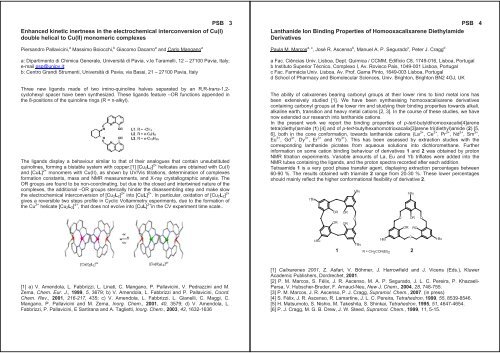ISMSC 2007 - Università degli Studi di Pavia
ISMSC 2007 - Università degli Studi di Pavia
ISMSC 2007 - Università degli Studi di Pavia
You also want an ePaper? Increase the reach of your titles
YUMPU automatically turns print PDFs into web optimized ePapers that Google loves.
PSB 3<br />
Enhanced kinetic inertness in the electrochemical interconversion of Cu(I)<br />
double helical to Cu(II) monomeric complexes<br />
Piersandro Pallavicini, a Massimo Boiocchi, b Giacomo Dacarro a and Carlo Mangano a<br />
a: Dipartimento <strong>di</strong> Chimica Generale, <strong>Università</strong> <strong>di</strong> <strong>Pavia</strong>, v.le Taramelli, 12 – 27100 <strong>Pavia</strong>, Italy;<br />
e-mail psp@unipv.it;<br />
b: Centro Gran<strong>di</strong> Strumenti, <strong>Università</strong> <strong>di</strong> <strong>Pavia</strong>, via Bassi, 21 – 27100 <strong>Pavia</strong>, Italy<br />
Three new ligands made of two imino-quinoline halves separated by an R,R-trans-1,2cyclohexyl<br />
spacer have been synthesized. These ligands feature –OR functions appended in<br />
the 8-positions of the quinoline rings (R = n-alkyl).<br />
The ligands <strong>di</strong>splay a behaviour similar to that of their analogues that contain unsubstituted<br />
quinolines, forming a bistable system with copper.[1] [Cu2L2] 2+ helicates are obtained with Cu(I)<br />
and [CuL] 2+ monomers with Cu(II), as shown by UV/Vis titrations, determination of complexes<br />
formation constants, mass and NMR measurements, and X-ray crystallographic analysis. The<br />
OR groups are found to be non-coor<strong>di</strong>nating, but due to the closed and intertwined nature of the<br />
complexes, the ad<strong>di</strong>tional –OR groups sterically hinder the <strong>di</strong>sassembling step and make slow<br />
the electrochemical interconversion of [Cu2L2] 2+ into [CuL] 2+ . In particular, oxidation of [Cu2L2] 2+<br />
gives a reversible two steps profile in Cyclic Voltammetry esperiments, due to the formation of<br />
the Cu 2+ helicate [Cu2L2] 4+ , that does not evolve into [CuL] 2+ in the CV experiment time scale..<br />
[1] a) V. Amendola, L. Fabbrizzi, L. Linati, C. Mangano, P. Pallavicini, V. Pedrazzini and M.<br />
Zema, Chem. Eur. J., 1999, 5, 3679; b) V. Amendola, L. Fabbrizzi and P. Pallavicini, Coord.<br />
Chem. Rev., 2001, 216-217, 435; c) V. Amendola, L. Fabbrizzi, L. Gianelli, C. Maggi, C.<br />
Mangano, P. Pallavicini and M. Zema, Inorg. Chem., 2001, 40, 3579; d) V. Amendola, L.<br />
Fabbrizzi, P. Pallavicini, E Sartirana and A. Taglietti, Inorg. Chem., 2003, 42, 1632-1636<br />
PSB 4<br />
Lanthanide Ion Bin<strong>di</strong>ng Properties of Homooxacalixarene Diethylamide<br />
Derivatives<br />
Paula M. Marcos a, c , José R. Ascenso b , Manuel A. P. Segurado c , Peter J. Cragg d<br />
a Fac. Ciências Univ. Lisboa, Dept. Química / CCMM, E<strong>di</strong>fício C8, 1749-016, Lisboa, Portugal<br />
b Instituto Superior Técnico, Complexo I, Av. Rovisco Pais, 1049-001 Lisboa, Portugal<br />
c Fac. Farmácia Univ. Lisboa, Av. Prof. Gama Pinto, 1649-003 Lisboa, Portugal<br />
d School of Pharmacy and Biomolecular Sciences, Univ. Brighton, Brighton BN2 4GJ, UK<br />
The ability of calixarenes bearing carbonyl groups at their lower rims to bind metal ions has<br />
been extensively stu<strong>di</strong>ed [1]. We have been synthesising homooxacalixarene derivatives<br />
containing carbonyl groups at the lower rim and studying their bin<strong>di</strong>ng properties towards alkali,<br />
alkaline earth, transition and heavy metal cations [2, 3]. In the course of these stu<strong>di</strong>es, we have<br />
now extended our research into lanthanide cations.<br />
In the present work we report the bin<strong>di</strong>ng properties of p-tert-butyl<strong>di</strong>homooxacalix[4]arene<br />
tetra(<strong>di</strong>ethyl)amide (1) [4] and of p-tert-butylhexahomotrioxacalix[3]arene tri(<strong>di</strong>ethyl)amide (2) [5,<br />
6], both in the cone conformation, towards lanthanide cations (La 3+ , Ce 3+ , Pr 3+ , Nd 3+ , Sm 3+ ,<br />
Eu 3+ , Gd 3+ , Dy 3+ , Er 3+ and Yb 3+ ). This has been assessed by extraction stu<strong>di</strong>es with the<br />
correspon<strong>di</strong>ng lanthanide picrates from aqueous solutions into <strong>di</strong>chloromethane. Further<br />
information on some cation bin<strong>di</strong>ng behaviour of derivatives 1 and 2 was obtained by proton<br />
NMR titration experiments. Variable amounts of La, Eu and Yb triflates were added into the<br />
NMR tubes containing the ligands, and the proton spectra recorded after each ad<strong>di</strong>tion.<br />
Tetraamide 1 is a very good phase transfer agent, <strong>di</strong>splaying extraction percentages between<br />
60-90 %. The results obtained with triamide 2 range from 20-30 %. These lower percentages<br />
should mainly reflect the higher conformational flexibility of derivative 2.<br />
t -Bu<br />
t-Bu<br />
OR<br />
OR<br />
1<br />
OR<br />
OR<br />
t-Bu<br />
O<br />
t - Bu<br />
t-Bu<br />
R = CH 2 CON(Et) 2<br />
t-Bu<br />
O OR O<br />
OR RO<br />
[1] Calixarenes 2001, Z. Asfari, V. Böhmer, J. Harrowfield and J. Vicens (Eds.), Kluwer<br />
Academic Publishers, Dordrechet, 2001.<br />
[2] P. M. Marcos, S. Félix, J. R. Ascenso, M. A. P. Segurado, J. L. C. Pereira, P. Khazaeli-<br />
Parsa, V. Hubscher-Bruder, F. Arnaud-Neu, New J. Chem., 2004, 28, 748-755.<br />
[3] P. M. Marcos, J. R. Ascenso, P. J. Cragg, Supramol. Chem., <strong>2007</strong>. (in press)<br />
[4] S. Félix, J. R. Ascenso, R. Lamartine, J. L. C. Pereira, Tetrahedron, 1999, 55, 8539-8546.<br />
[5] H. Matsumoto, S. Nishio, M. Takeshita, S. Shinkai, Tetrahedron, 1995, 51, 4647-4654.<br />
[6] P. J. Cragg, M. G. B. Drew, J. W. Steed, Supramol. Chem., 1999, 11, 5-15.<br />
O<br />
2<br />
t-Bu

















